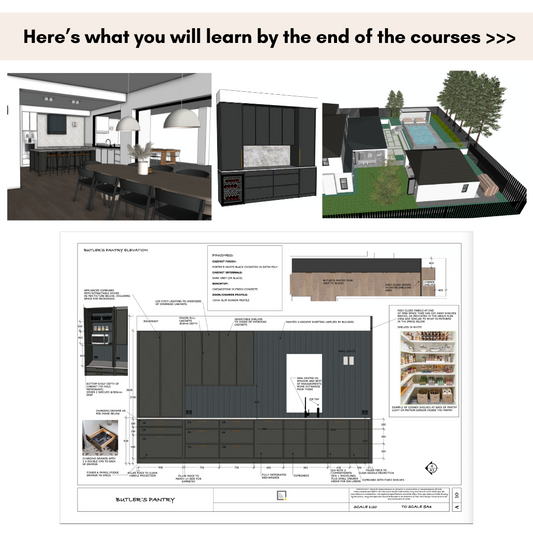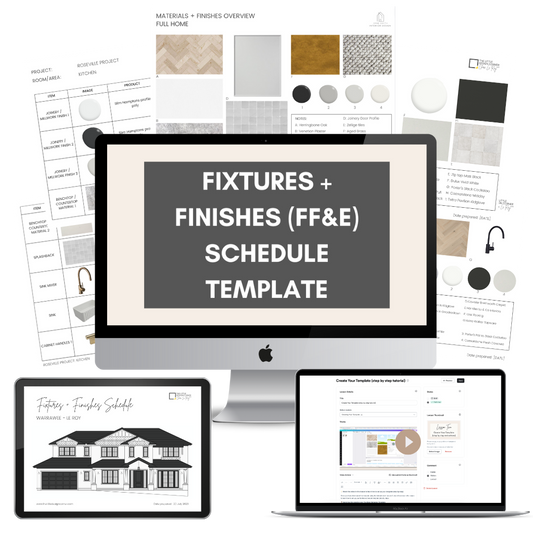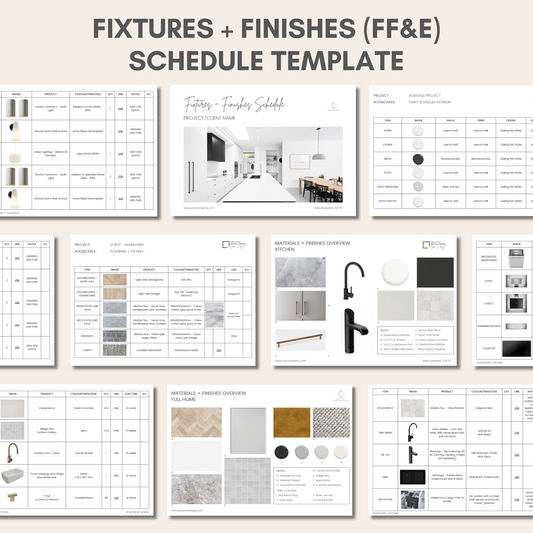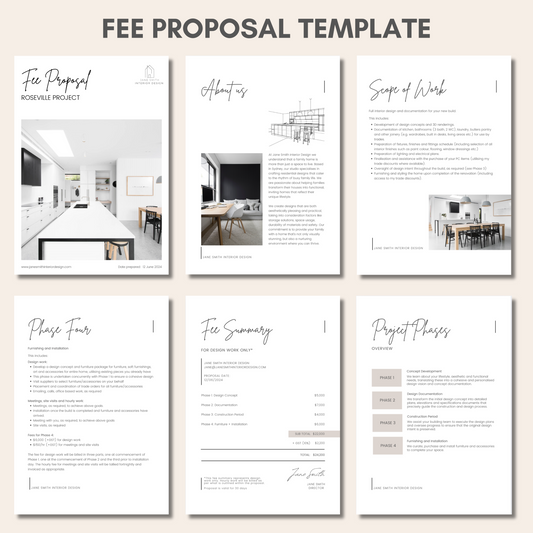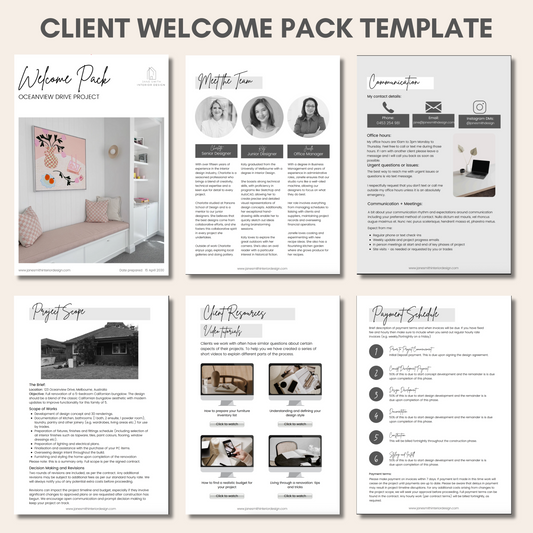This one is always a controversial “hot” topic!
Designers generally have very strong views on how things should be done and whether or not designers should pass on their discounts. Hearing such strong views for either side of the argument can be confusing, especially for designers new to the industry, so what I want to do in this article is to just present you with the options you have when it comes to trade discounts and help you understand the pros and cons of the different options.
But I also have a very particular view on this topic, which is not the way all designers think about it, so I’ll share that as we go on as well :)
There’s also some important legal issues that relate to passing on trade discounts including what you should include in your client agreements, what you should write on invoices, disclosure, conflict of interest and a whole bunch of other factors as well.
Many designers don’t actually realise the legal and risk implications of this topic and don’t seek appropriate legal advice on this part of their business. So please make sure you get your own advice on what is most suitable for your business model, especially if you are keeping some or all of the trade discounts you are securing.
This article is not intended to be legal advice, it is my observations of what I have seen happen within the industry, so please make sure you speak with a lawyer about this and make sure you are doing business legally.
What options do designers have with trade discounts?
So what are trade discounts anyway?
These are the discounts that interior designers, decorators, architects or others working in the design industry can get with the suppliers they work with - e.g. the suppliers who sell furniture, fabric, window dressings, bathroom and kitchen fixtures, appliances etc.
Here’s an example of how it works:
-
An interior designer might suggest a sofa and console table from a particular furniture store for their clients.
-
The sofa and console may sell at retail price for $15,000 - this is the advertised price on a website or if a client called up to ask about pricing
-
Generally before suggesting these pieces to their clients the designer would contact the supplier and find out about their trade program and see whether that supplier offers a trade discount (or they might already be a trade supplier for the designer from previous projects)
-
In this example the supplier may offer a 10% discount to the designer on the sofa and console - which would be a $1,500 discount, making the sofa and console now $13,500.
-
If the client goes ahead with purchasing the recommended sofa and console then when the purchase happens the designer has three choices for what to do with the trade discount they have secured:
-
1: Keep the full discount: the designer would invoice the client for the full $15,000 of the sofa and console table and wait for payment. Once they are paid by the client they would arrange the discount in the back end with the supplier. The client pays the designer the full $15,000. The designer then pays the supplier $13,500 for the furniture (minus discount) and keeps the $1,500 discount. The client generally doesn’t interact with the supplier at all and the designer manages everything related to delivery, receiving goods, warranties, returns etc.
-
2: Share some of the discount with their client: the designer would keep part of the discount and pass some of the discount on to their client. So in our current example the discount here is 10% so perhaps the designer would keep 5% ($750) and would pass the other 5% discount ($750) on to their client. So here the designer would invoice the client for $14,250 and wait for payment. Once they are paid by the client they would arrange the discount in the back end with the supplier. So the client pays the designer $14,250. The designer then pays the supplier the $13,500 for the furniture and keeps $750 (their 5% of the discount). Again the client generally doesn’t interact with the supplier in this instance and the designer manages everything related to delivery, receiving goods, warranties, returns etc.
-
3: Pass on the full discount: in this option the designer would pass the full 10% ($1500) discount on to their client. So the designer would contact their supplier and arrange the discount and place the order. Once finalised the supplier would then typically email the designer the trade invoice (i.e. for $13,500 in our example) and the designer would then forward this on to their client directly for payment (theres’s a few ways of doing this but that’s how I would work). The designer would email and let the supplier know that the client will be contacting them directly to make payment. The client then contacts the supplier and arranges payment for the $13,500. The client and supplier then normally make arrangements for delivery and receiving the goods plus the client is responsible for warranties, returns, faulty goods etc. and managing this with the supplier (again there’s a few options for how this part is managed but that’s how I did this with clients).
-
But just to be clear the trade discount belongs to the designer - not to the client. So it’s their choice what they do with it.
The trade discounts are offered to designers as a way of suppliers thanking the designer for selecting products from them and to encourage the designer to do business with them. It’s also an industry accepted standard that most suppliers will offer a discount to trade clients (i.e. designers and others in the industry).
So it’s completely up to the designer whether or not that discount is passed on to the client or kept by the designer.
And in the design industry all three of the options above happen all the time and there is no right or wrong way to approach this - it’s entirely up to you and how you want to run your business.
But there are definitely pros and cons for each of the three options mentioned above - plus legal and risk issues to consider as well - so I am going to share those below for you so you can make an informed choice about which option is best for you.
Keeping your full trade discount
Passing trade discounts on has been an industry standard for a long time in the design industry. In fact when I raise this topic in posts on social media (the ones that can get very heated!) the reason most cited for why designers pass on their trade discount is “because all the big designers do it” or “everyone else is doing it so that’s how I do it too”.
In fact many designers make a good portion of their revenue from trade discounts and often offer slightly lower consultation or design fees to clients to make up for this, so these trade discounts become a really important part of their business model and can be a revenue stream in itself.
Although there are a number of pros of keeping your full trade discount, in my opinion the negatives far out weigh the positives - but let me lay out each below.
Pros of keeping your trade discounts:
-
it is an additional revenue stream in your business that can make good money in the right business model (i.e. if your business is largely styling or sourcing products then this could be lucrative)
-
you can charge lower design fees to make up for having revenue from trade discounts
-
there is less administration for the clients - especially if ordering a lot of items
-
you feel compensated for time spent researching products, building supplier relationships and placing orders
-
the industry has worked like this for a long time and many clients just expect this is how it is (even though most clients don’t like it for reasons I will outline below)
Cons of keeping your trade discounts:
-
you are essentially on-selling a product and this involves risk for your business
-
it can be hugely time consuming to manage and be responsible for all the products you are sourcing across multiple client projects
-
there is a lot of risk involved in the supply, payment and handling of products on behalf of a client (and it’s really important you get a legal opinion on this one as it’s quite a serious risk for a small business)
-
there can be a huge amount of administrative burden for designers when they keep the trade discount as they are essentially responsible for all aspects of the product handling including:
-
doubling up on invoices (i.e. having to invoice clients separately for something the supplier has already invoiced you for)
-
dealing with tax issues - e.g. adding taxes, removing taxes, accounting for taxes in your returns
-
checking and approving paperwork (and being responsible if there are errors)
-
arranging deliveries and being on site when things are delivered
-
unpacking and rubbish removal
-
checking for faults/quality control
-
being responsible for returns and replacements on stock that is damaged
-
warranties and issues that may happen months or years down the track
-
-
sometimes the discount you get paid for a product isn’t actually worth the time you spend on the administrative side of arranging it - e.g. you may arrange for the purchase of a $500 coffee table and you may get $50 of that (10% discount) - but you may then spend 5 hours on invoicing, admin, being on site for delivery and dealing with problems if the coffee table is faulty or there are issues with it down the track - so you’ve really only been paid $50 for 5 hours of your time (= $10 per hour which is not worth it in my opinion!)
-
if you’ve paid on behalf of a client then if something goes wrong or there’s a disruption in the project timeline or supply chain during a project then fault for this can fall to the designer (again not legal advice - just what I have seen happen many times)
-
it’s a poor client experience - many clients feel there’s a lack of transparency with designers that keep their discounts
-
it can affect your insurance and increase your premiums (due to assuming the risk of on-selling product) - check this with your individual insurer
-
it can appear to be a conflict of interest to clients - e.g. if a designer is pushing for the $15,000 sofa over the $10,000 sofa is it because the sofa is actually the better choice or is it because the designer get a bigger financial return on choosing the more expensive product?
-
if clients know you are keeping your discount they will often try and go behind your back to source better pricing for themselves. There’s so much competition for customers these days that sometimes the supplier will give them a 5% discount just because they ask - when your discount might be 10%…the client is still getting a better deal that way and I’ve heard of so many times where the client then purchases the piece behind the clients back to get a better price - so then the designer has not only missed out on their discount but they have also now not charged enough for the design fees to make up for that. This can obviously cause a lot of tension in the client and designer relationship!
So although keeping the trade discount may seem like it is an additional revenue stream for many designers it actually comes with a hidden cost that most designers don’t factor in.
Namely the time it takes to manage the backend administrative process and also (more importantly) the inherent risk to the designers’ business in terms of what happens if something goes wrong or there are issues with the product purchased on the clients’ behalf.
In fact very few designers I speak with understand the risk they are taking on by keeping trade discounts.
So if you are going to keep your discount (or even only part of it) then I strongly encourage you to make sure you have something in your client agreement about how you work and disclose exactly what discounts you are keeping or offering so this is clear up front and fully transparent.
In many jurisdictions it’s also a legal requirement that you disclose your discount on the invoice you send the client, which many designers don’t realise (and don’t do).
So I would strongly suggest you speak with a lawyer if you are keeping any trade discounts and don’t have your legal ‘ducks in a row’ on this matter as you are exposing yourself to a lot of potential risk in your business and even unknowingly perhaps doing business illegally.
Keeping part of your trade discount and passing some to the client
Although keeping part of the discount yourself and passing some of it on to your clients may seem like a good middle ground between the two other options I am presenting above and below I actually think this is worse.
The thing most designers don’t realise is that with this option they actually still take on a lot of the risks outlined above and still have to do all the administrative work and product handling to take care of, but this time they are only doing it for part of their discount!
So in my opinion this is an even worse idea than actually keeping the full discount or passing it on in full.
Pros of keeping part of your trade discounts:
-
feels like a good middle path to keep some of the discount and give some to your client
-
gives you some additional revenue (but can be very small for the work involved)
Cons of keeping part of your trade discounts:
-
often when you’ve split your discount the client can get a discount of similar value themselves by speaking with the supplier directly
-
most of the cons outlined above still apply to this option…
Passing on your trade discount in full
So that brings us to passing your trade discount on in full and in my opinion this is by far the best way to work.
The way I look at it is that when a client pays me a design fee they are paying me for my time, expertise, creative ideas, sourcing time, supplier contacts and everything else that comes with being a designer. I also think that one of the perks of working with an interior designer is that you get access to trade discounts and better priced goods that you can source for yourself.
That’s not to say that the client should get all of this for nothing of course!
In fact I charged higher fees to my design clients than other designers that I knew were charging. And the reason I could justify this is because I could clearly show my clients the financial benefit of working with me. I could state, for example, that if we were furnishing a full house for $100,000 and then I charged $10,000 in design fees for this project I could say, without question, that my clients would get back most (if not all) of my design fees in the trade discounts I could secure for them.
I saw this as a win/win. My client was happy as they felt they were getting their design work ‘for free’ but I saw it differently. I got paid well to do the part of my job that I loved the most (designing) and didn’t have to deal with any of the administrative headaches or risk involved with purchasing products on a clients’ behalf (which I really don’t enjoy!).
I also found that it made it very easy for a client to say yes to working with me - which ultimately meant more client projects and more business.
Pros of passing on your trade discounts in full:
-
For me the biggest reason to pass on my discounts is due to transparency - it’s very easy to tell clients that’s what I do, they understand where they stand and there’s never any need for them to feel they have to go behind my back to try and ‘get a better deal’ with suppliers
-
You avoid any potential conflict of interest (or clients seeing things this way) - clients won’t think you’re recommending a more expensive product because you get a better cut, they will believe you when you tell them it’s because it is actually the better product for their space.
-
You can charge higher design fees and clearly show clients the financial exchange of value
-
No embarrassing issues with clients contacting suppliers directly - suppliers do make mistakes and tell clients about different trade arrangements. They aren’t meant to disclose trade pricing to the public but I’ve heard of it happening so many times and it can be very embarrassing for the designer if things haven’t been disclosed properly
-
You don’t get involved in warranties, exchanges, faulty products etc. The clients deal directly with the supplier on those matters and you stay out of it, which saves you time and helps avoid risk for your business.
Cons of passing on your trade discounts in full:
-
many designers say that suppliers don’t like it when the trade discount is passed on to clients in full - but I don’t believe this is true (see my notes below on this)
-
on the surface it can seem like you are missing out on a revenue stream - but if you read my notes above on the inherent risks and extra time associated with keeping your discounts then perhaps you can see why this argument isn’t really correct
So as you can probably tell I’m very supportive of the idea of passing trade discounts on in full. It’s the way I worked with clients myself and I can tell you from first hand experience that even if you pass your trade discounts on in full you can still build a very successful and profitable business (as that’s exactly what I did myself).
It’s also important to note that there can be differences in the way large design companies work vs working for smaller residential clients and I haven’t covered that distinction in this article.
In fact it’s very common for commercial designers who work B2B (business to business - i.e. on a fit out of a commercial office space for example) to keep their trade discounts and not pass these to their clients. This is part of their particular business model and is a bit different to smaller scale residential work. I only worked as a residential designer so can’t really comment on that aspect of the industry.
“But suppliers don’t like it”…
Whenever I talk about my opinion on trade discounts on my social media or elsewhere I inevitably get lots of designers’ noses out of joint as so many of them keep their discounts (which is completely their choice of course!).
And one argument that comes up time and again is that designers feel their suppliers don’t like the trade discount to be passed on to their clients.
They tell me that their suppliers prefer the discount to be kept by the designer and not passed on. But in my experience of working with hundreds of suppliers of nearly 8 years I can tell you that I’ve never once heard a supplier tell me this!
Think about it from a supplier perspective and what they are essentially “paying” for by giving you a trade discount:
-
no customer acquisition cost (CAC) - the supplier has no marketing or other cost to them for the client you bring them - all businesses (even you!) have a cost of customer acquisition and free clients are worth a huge amount to any business
-
your loyalty and the repeat business you bring them (at no CAC to them)
-
it costs them the same amount whether you keep the discount or pass it to your client - makes no difference to their bottom line either way
So if you, as the designer, are bringing a supplier repeat business and new clients all the time then why on earth would they be worried about where that discount goes and whether your client keeps it or whether you keep it?
The most important thing is that you are very open with your supplier about the fact you pass on your discounts (if this is what you choose to do). There are some suppliers who may get upset by you passing on your discounts to clients if you don’t disclose that this is what you’re doing. So it’s again all about transparency and being honest about what you are doing.
If you do have an issue with a supplier (I never have, but just in case you do!) then the argument I would go back with is what I have laid out above. Explain to them that it actually doesn’t make a difference to their bottom line where the discount goes and that they are essentially paying for your loyalty and the ‘free’ clients you are bringing to their business.
Which way is the ‘right’ way?
Whenever I’m deciding how to run my business I always put myself in the shoes of my clients and think about what the experience would be like for them. And that’s the guiding principle I used when I was deciding whether or not to pass on trade discounts.
Overall the important thing to remember is that there is no right or wrong answer to this question.
No matter what you decide the most important thing is to understand what risk you hold with any of the options presented here and also to be open and transparent with all stakeholders about what you are doing.
So make it clear to clients what you do and make it clear to suppliers what you do and be honest and open with everyone involved in the transaction - that way you will avoid getting involved in any embarrassing, risky or expensive problems.
What I have done in this article is presented the different options you have and my argument for why I strongly believe in passing on your trade discounts in full.
But the joy of running your own business is you get to do it your way! 🥳🥳🥳
So be informed, get the appropriate advice from the appropriate professionals and then make the decision that feels most right for you :)





